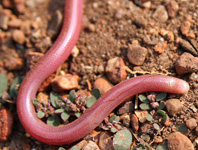Abstract
A new species of blind snake in the genus Letheobia is described from Akagera National Park in eastern Rwanda. The new species is most similar to species of the L. gracilis complex, particularly L. gracilis and L. graueri. It differs from all other species of the genus by a unique combination of morphological characters, including the highest number of middorsal scale rows (834) and the most extreme elongation (total-length/midbody-width ratio 131) of all species in the genus and of any species of snake in the world; 22-22-22 longitudinal scale rows; snout in dorsal profile rounded, in lateral profile bluntly rounded with an angular horizontal edge ventrally; rostral broad, posteriorly rounded; eyes invisible; supralabial imbrication pattern T-0; tail short (1.3 percent of total length) with an apical spine; and a pink life colouration. The holotype of the new species was collected in gallery forest at a lake shore surrounded by savanna at 1300 m elevation. We produced scanning electron microscope images of the heads of the investigated specimens applying a liquid-substitution preparation procedure which does not require coating or drying and thus does not irreversibly damage the investigated samples. The obtained images allow an easy and more accurate examination of the scalation.
References
Anderson, T.F. (1951) Techniques for the preservation of three dimensional structure in preparing specimens for the electron microscope. Transactions of the New York Academy of Sciences, 13, 130–134.
https://doi.org/10.1111/j.2164-0947.1951.tb01007.xAota, S. (1940) An histological study on the integument of a blind snake, Typhlops braminus (Daudin), with special reference to the sense organs and nerve ends. Journal of Science of the Hirosima University, Series B, 7, 193–208, 1 pl.
Boyde, A. (1978) Pros and cons of critical point drying and freeze drying for SEM. Scanning Electron Microscopy, 1978, 303–314.
Broadley, D.G. & Wallach, V. (2007) A review of East and Central African species of Letheobia Cope, revived from the synonymy of Rhinotyphlops Fitzinger, with descriptions of five new species (Serpentes: Typhlopidae). Zootaxa, 1515, 31–68.
de Witte, G.-F. (1933) Description de reptiles nouveaux provenant du Katanga (1930-31). Revue de Zoologie et de Botanique Africaines, 23 (2), 185–192.
de Witte, G.-F. (1953) Reptiles. In: Exploration du Parc National de l’Upemba. Mission de G.F. de Witte en collaboration avec W. Adam, A. Janssens, L. van Meel et R. Verheyen (1946–1949). Fascicule 6. Institut des Parcs Nationaux du Congo Belge, Bruxelles, 322 pp., 41 pls.
de Witte, G.-F. (1966) Reptiles. In: Exploration du Parc National de la Garamba, Mission H. de Saeger en collaboration avec P. Baert, G. Demoulin, I. Denisoff, J. Martin, M. Micha, A. Noirfalise, P. Schoemaker, G. Troupin et J. Verschuren (1949–1952). Institut des Parcs Nationaux du Congo, Bruxelles, pp. 1–108, pls. 1–5.
Ensikat, H.-J. & Barthlott, W. (1993) Liquid substitution: A versatile procedure for SEM specimen preparation of biological materials without drying or coating. Journal of Microscopy, 172, 195–203.
https://doi.org/10.1111/j.1365-2818.1993.tb03413.xEnsikat, H.-J. (1996) Liquid substitution methods. Preparation of biological specimens by liquid substitution (LS). In: Robards, A.W. & Wilson, A.J. (Eds.), Procedures in Electron Microscopy. John Wiley & Sons, Chichester, pp. 66–76. [pp. 10:2:66–10:2:76]
Ensikat, H.-J., Ditsche-Kuru, P. & Barthlott, W. (2010) Scanning electron microscopy of plant surfaces: simple but sophisticated methods for preparation and examination. In: Méndez-Vilas, A. & Díaz, J. (Eds.). Microscopy: Science, Technology, Applications and Education. FORMATEX, Badajoz, pp. 248–255.
Ensikat, H.-J. & Weigend, M. (2014) SEM of biological samples without coating utilizing bulk conductivity for increased versatility. G.I.T. Imaging & Microscopy, 2014 (1), 2–4.
IUCN (2017) The IUCN Red List of Threatened Species. Version 2017-1. Available from: http://www.iucnredlist.org (accessed 12 May 2017)
Jackson, M.K. (1977) Histology and distribution of cutaneous touch corpuscles in some leptotyphlopid and colubrid snakes (Reptilia, Serpentes). Journal of Herpetology, 11, 7–15.
https://doi.org/10.2307/1563285Hedges, S.B., Marion, A.B., Lipp, K.M., Marin, J. & Vidal, N. (2014) A taxonomic framework for typhlopid snakes from the Caribbean and other regions (Reptilia, Squamata). Caribbean Herpetology, 49, 1–61.
Landmann, L. (1975) The sense organs in the skin of the head of Squamata (Reptilia). Israel Journal of Zoology, 24, 99–135.
Laurent, R.F. (1956) Contribution à l'herpetologie de la région des Grands Lacs de l'Afrique centrale. Annales du Musée Royal du Congo Belge, Sciences Zoologiques, 48, 1–390.
Leydig, F. (1868) Ueber Organe eines sechsten Sinnes. Zugleich als Beitrag zur Kenntniss des feineren Baues der Haut bei Amphibien und Reptilien. E. Blochmann & Sohn, Dresden, iv + 108 pp., 5 pls.
Malonza, P.K., Bauer, A.M. & Ngwava, J.M. (2016) A new species of Letheobia (Serpentes: Typhlopidae) from central Kenia. Zootaxa, 4093 (1), 143–150.
https://doi.org/10.11646/zootaxa.4093.1.10Pyron, R.A. & Wallach, V. (2014) Systematics of the blindsnakes (Serpentes: Scolecophidia: Typhlopoidea) based on molecular and morphological evidence. Zootaxa, 3829 (1), 1–81.
https://doi.org/10.11646/zootaxa.3829.1.1Sternfeld, R. (1910) Neue Schlangen aus Kamerun, Abessynien und Deutsch-Ostafrika. Mitteilungen aus dem Zoologischen Museum in Berlin, 5, 67–70.
Sternfeld, R. (1912) IV. Zoologie II. Lfg. Reptilia. In: Schubotz, R. (Ed.), Wissenschaftliche Ergebnisse der Deutschen Zentral-Afrika Expedition 1907- 1908, unter Führung A. Friedrichs, Herzogs zu Mecklenburg. Klinkhard und Biermann, Leipzig, pp. 197–279.
Wallach, V. (1993) The supralabial imbrication pattern of the Typhlopoidea (Reptilia: Serpentes). Journal of Herpetology, 27, 214–218.
https://doi.org/10.2307/1564940Wallach, V. (2009) Ramphotyphlops braminus (Daudin): a synopsis of morphology, taxonomy, nomenclature and distribution (Serpentes: Typhlopidae). Hamadryad, 34, 34–61.
Wallach, V. & Ineich, I. (1996) Redescription of a rare Malagasy blind snake, Typhlops grandidieri Mocquard, with placement in a new genus (Serpentes: Typhlopidae). Journal of Herpetology, 30, 367–376.
https://doi.org/10.2307/1565174Wallach, V., Williams, K.L. & Boundy, J. (2014) Snakes of the world: a catalogue of living and extinct species. CRC Press, Taylor & Francis Group, Boca Raton, Florida, 1237 pp.
https://doi.org/10.1201/b16901

